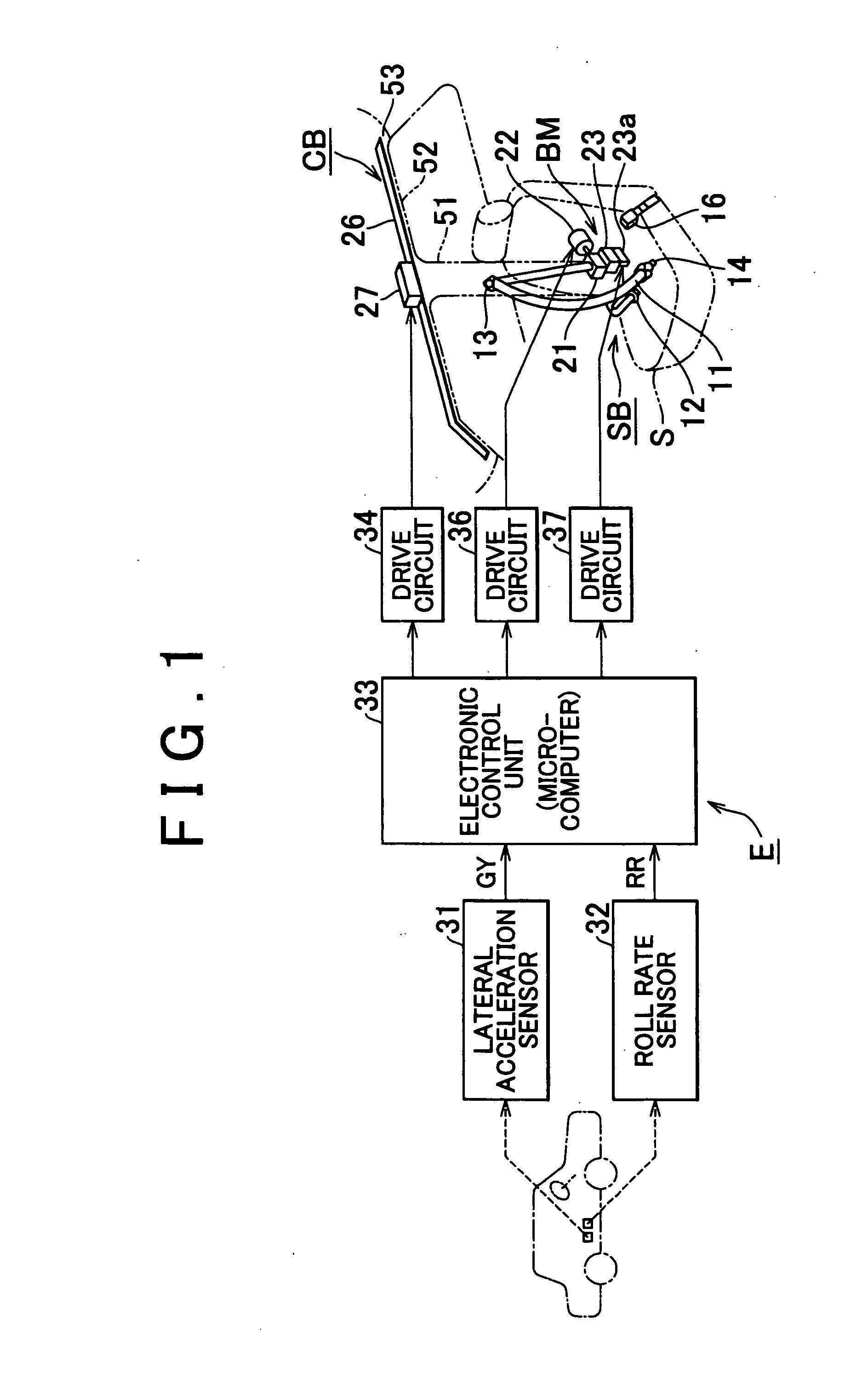Seat belt apparatus for vehicle
a seat belt and vehicle technology, applied in the direction of process and machine control, pedestrian/occupant safety arrangement, instruments, etc., can solve the problem of short time required for the second belt retractor to finish retracting the seat belt, and achieve the effect of reliably restrainting the occupan
- Summary
- Abstract
- Description
- Claims
- Application Information
AI Technical Summary
Benefits of technology
Problems solved by technology
Method used
Image
Examples
first embodiment
[0023]FIG. 1 is a block diagram schematically showing an entire occupant protection system employing a seat belt apparatus according to the first embodiment. The occupant protection system protects an occupant when the vehicle rolls over. The occupant protection system includes a seat belt apparatus and a curtain bag apparatus associated with the seat belt apparatus. Both the seat belt apparatus and the curtain bag apparatus have an electric control device E. The seat belt apparatus has a seat belt mechanism portion SB, and the curtain bag apparatus has a curtain bag mechanism portion CB. The seat belt mechanism portion SB can retract a seat belt when a vehicle rolls over. The seat belt mechanism portion SB includes a seat belt 11 provided on one side of a seat S, an anchor 12, a slip joint 13, a tongue blade 14, a belt retractor BM, and a buckle 16 provided on the other side of the seat S.
[0024] One end of the seat belt 11 is connected to the anchor 12, and the other end of the se...
second embodiment
[0047] Next, a second embodiment of the invention will be described. The electronic control unit 33 according to the second embodiment of the invention stores a seat belt retracting control program shown in FIG. 4, instead of the seat belt retracting control program shown in FIG. 2, and repeatedly executes the control program in FIG. 4 at predetermined short time intervals. Other portions of the configuration are the same as in the first embodiment.
[0048] The seat belt retracting control program starts in step 200. After the lateral acceleration GY and the roll rate RR are input, the roll rate RR is integrated with respect to time so as to calculate the roll angle RA in steps 202 to 206 that are the same as steps 102 to 106, respectively.
[0049] First, a case where there is no possibility of rollover of the vehicle will be described. In this case, negative determinations are made in steps 208 and 210 that are the same as steps 112 (or 116) and 110, and the seat belt retracting cont...
third embodiment
[0060] Next, a third embodiment of the invention will be described. The electronic control unit 33 according to the third embodiment of the invention stores a seat belt retracting control program shown in FIG. 6, instead of the seat belt retracting control program shown in FIG. 2, and repeatedly executes the control program at predetermined short time intervals. Other portions of the configuration are the same as in the first embodiment.
[0061] The seat belt retracting control program starts in step 300. The lateral acceleration GY and the roll rate RR are input, and the roll rate RR is integrated with respect to time so as to calculate the roll angle RA in steps 302 to 306 that are the same as steps 102 to 106.
[0062] In a case where there is no possibility of rollover of the vehicle, negative determinations are made in all the steps 308 to 320. In step 322, the seat belt retracting control program is temporarily terminated. Predetermined values GY2, RR2, and RA2 in steps 308, 310,...
PUM
 Login to View More
Login to View More Abstract
Description
Claims
Application Information
 Login to View More
Login to View More - R&D
- Intellectual Property
- Life Sciences
- Materials
- Tech Scout
- Unparalleled Data Quality
- Higher Quality Content
- 60% Fewer Hallucinations
Browse by: Latest US Patents, China's latest patents, Technical Efficacy Thesaurus, Application Domain, Technology Topic, Popular Technical Reports.
© 2025 PatSnap. All rights reserved.Legal|Privacy policy|Modern Slavery Act Transparency Statement|Sitemap|About US| Contact US: help@patsnap.com



